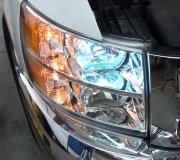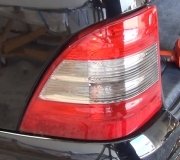To be technically correct, that would be an "open" circuit, meaning it has a break in it. A short would allow too much current to flow and would blow the fuse. Terminology aside, it sounds like you've located the area of the defect. The best approach now, if possible, is to shift to "reverse" with the ignition switch on, get it to the defective state, meaning the back-up lights are not lit, then test at each point in the circuit, in order, until you find where the 12 volts is lost.
Start at the dark blue wire. Back-probe that wire in the connector on the switch. Assuming you find 12 volts there, next, try to reach under the connector and touch the test light's probe to the corresponding terminal on the switch. If 12 volts is missing there, that terminal is spread or corroded and making intermittent contact.
If you do have 12 volts on the terminal, check on the other one corresponding to the light green wire. If that's the first place you find 12 volts missing, the contacts inside the switch are intermittent. Switch contacts are rarely affected by wiggling the connector. If doing that makes the lights flicker on and off, it's almost a sure thing one of those terminals is loose or corroded.
One more thing to be aware of. Your truck was built at a time when GM was using aluminum wire on some models instead of copper. Any place two different metals come in contact with an acid, you get "galvanic" action, meaning corrosion. There were many problems with the aluminum wires riveted to steel strips in the fuse box with brass rivets. Add road salt from your feet and it was fairly common to find loose / corroded rivets in the fuse box when it was in front of the brake pedal. You'll see that by the lights flickering on when you wiggle the wiring harness going into the fuse box. If it's fairly dark under the dash, you may see small sparks occurring at the point of the intermittent connection. You can't find a better clue than that as to the location of the bad connection.
If you do have aluminum wire in your truck, the insulation will be a translucent color, not a solid color like we're used to seeing. I never allowed my students to pierce a wire's insulation to take a reading, but that's even more important with aluminum wire. With a test hole pierced through the insulation of a copper wire, that copper will corrode within a few years, and that corrosion makes it impossible to solder to. With a hole in the insulation for an aluminum wire, that wire will corrode into aluminum oxide within a few weeks to perhaps as long as a couple of months, then you'll have another intermittent problem to diagnose. You'll see through the insulation the wire has turned to powder for a couple of inches from the hole. Aluminum oxide is also an insulator that prevents further corrosion, however, in areas where vibration or flexing is an issue, that knocks off the oxide coating allowing further corrosion to occur.
Let me know what you find.
Friday, March 4th, 2022 AT 11:06 AM






